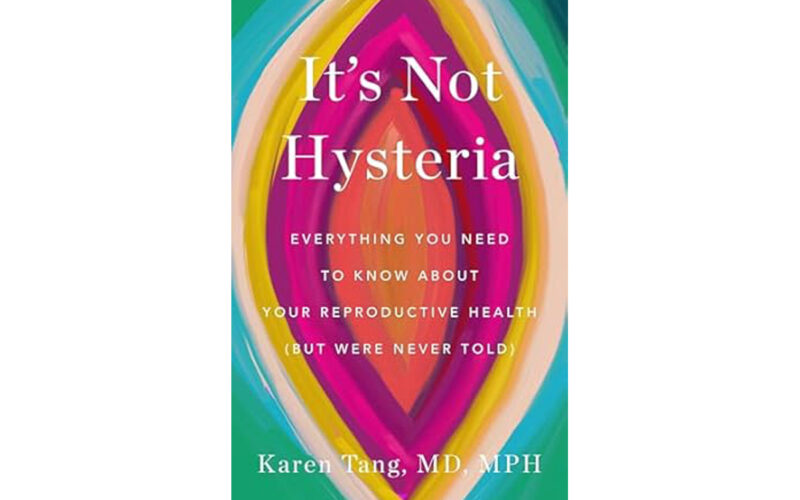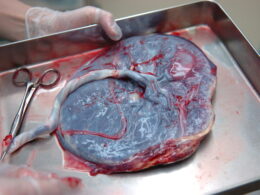Over the course of their lives, many women experience menstrual abnormalities, pain, or other pelvic problems. Yet these issues are overwhelmingly misunderstood, dismissed, misdiagnosed, and under-researched. If a doctor ever urged you to “just take birth control” or told you “everyone gets this kind of pain, there’s not much we can do,” you may have wondered whether you were crazy for asking questions about your reproductive health or for thinking there was something wrong.
Enter It’s Not Hysteria: Everything You Need to Know About Your Reproductive Health (But Were Never Told), by Karen Tang, MD, MPH. Dr. Tang wrote this book for the countless women she’s encountered in her own medical practice who have felt dismissed by doctors when it comes to their menstrual pain and reproductive issues.
It’s Not Hysteria is a comprehensive manual on women’s reproductive and gynecological health, but includes sections that some readers may find controversial. In this book review, I weigh the good and the bad, and recommend whether to buy, borrow, or skip It’s Not Hysteria.
What makes Dr. Tang an expert on reproductive health?
Dr. Tang is a board-certified gynecologist and minimally-invasive gynecologic surgeon who runs a private practice in Bryn Mawr, PA. She can be found on TikTok, Instagram, and YouTube as @KarenTangMD, and, according to her practice’s website, she “reaches millions of viewers each month with her educational videos that explain gynecologic health, pelvic pain, and reproductive rights in an entertaining and easily understandable way.”
Dr. Tang received her undergraduate degree in Biology at the University of Chicago, and her MD and Masters of Public Health at Columbia University. She completed her residency in OB/Gyn at Beth Israel Deaconess Medical Center/ Harvard, and her fellowship in minimally invasive gynecologic surgery at Legacy Health in Portland, OR. Dr. Tang is also a speaker on reproductive health issues, and one of the few experts on pelvic pain in the Philadelphia area.
Who is It’s Not Hysteria for?
It’s Not Hysteria is for any woman with a uterus, with the goal of empowering women to take concrete steps to take control of their health. For Dr. Tang, this starts with women understanding and moving toward important conversations with their doctors. She argues that women have suffered enough, and believes that “just because a biological function can be painful, doesn’t mean that the pain is acceptable” (p. 3). Dr. Tang hopes readers will “think of this book as a greatest-hits collection of gynecologic topics” (p. 2).
Dr. Tang argues that women have suffered enough, and believes that “just because a biological function can be painful, doesn’t mean that the pain is acceptable”
What does It’s Not Hysteria cover?
The book starts with the “history of hysteria,” or the historical, habitual dismissal of women’s reproductive and gynecological issues by medical professionals. The word hysteria itself comes from the Greek hystera meaning “uterus.” In Ancient Greece, hysteria was “thought to be a combination of physical, emotional, and psychological distress… tied to the uterus or womanhood” (p. 10). She provides a broad overview of female anatomy, sex ed (including basics of the female menstrual cycle and conception), and some tips for communicating with your healthcare professional.
Part II covers gynecologic conditions including fibroids, endometriosis, PCOS, sexual dysfunction, premenstrual syndrome, infertility, and menopause. Each chapter starts with a basic overview of the condition, how doctors diagnose the condition, symptoms, and treatment options.
Part III includes types of treatments (different types of birth control, for example), the “why” behind certain treatments, and an overview of risks and side effects. She includes hormonal birth control, hysterectomy, and abortion among these treatments. Dr. Tang shares her stance on abortions as “medical treatments, and like any other medical decision, people should have the autonomy to choose the option that is best for their health and well-being” (p. 293). (For a more nuanced discussion of abortion than Dr. Tang offers in her book, see Natural Womanhood’s “Abortion and Women’s Health” topic page.)
The book concludes with a call-to-action to take the information readers have learned about their reproductive health to their doctors. Women are often left to be their own advocates to get the care they need, which is why it can take years for a proper diagnosis. Dr. Tang hopes readers will be informed and empowered to shorten the time to diagnosis, and know they don’t have to live with pain or debilitating symptoms.
Women are often left to be their own advocates to get the care they need, which is why it can take years for a proper diagnosis.
Strengths of It’s Not Hysteria
It’s comprehensive
This book covers almost every reproductive health condition you can imagine. Dr. Tang also provides much more information than the average woman likely receives in a few minutes with her primary care physician or gynecologist during an annual visit. In many cases, doctors don’t “have enough time to fully explore complex medical problems” during these visits.
The chapters are well laid out, and detailed enough to be informative while still accessible to the average lay-woman. Dr. Tang educates readers on the potential causes of, and risk factors for, a condition and the various symptoms and all potential treatment options. She includes over 300 references from credible sources, such as peer-reviewed journal articles, the Centers for Disease Control and Prevention (CDC), and the U.S. Food and Drug Administration (FDA). I appreciated the knowledge I gained about various reproductive issues I haven’t personally experienced, because it helps me better relate to friends who have one or more of the conditions in this book.
It advocates for more women’s health research
The tone throughout the book is one that should be welcome to Natural Womanhood readers. She argues that women’s reproductive health and women’s health in general are under-researched and understudied. She concludes her book with a reminder that women’s reproductive health needs funds dedicated to it to improve.
Case in point, Dr. Tang writes:
“Eighty percent of Black women will develop fibroids in their lifetime…. Imagine if there was a condition that affected 80 percent of white men and caused hemorrhaging, debilitating pain, severe bloating, constipation, frequent urination, and infertility. I’d wager that scientists would have long ago discovered the exact biological cause, and there would be a range of effective treatment options available and covered by insurance.”
Limitations or blind spots
A focus on pharmaceutical treatments
This book, while providing a wealth of knowledge on a vast array of women’s health conditions, unmistakably comes from the conventional medical perspective, which does not view a woman’s fertility cycle as integral to her health and well-being. Almost every chapter has some mention of hormonal birth control, and it’s clear that Dr. Tang still perceives birth control as a viable option and even cornerstone of treatment for many reproductive health conditions, despite the fact that it is a band-aid solution at best.
Ideological issues
Dr. Tang mentions birth control frequently and while she states that “like any medical treatment, birth control methods are simply tools; they have benefits and risks,” she does not get into the nitty-gritty of the numerous side effects of hormonal birth control. We’ve written extensively about the harms of birth control, why women need periods, and how ovulation is a sign of overall health–truly, a woman’s fifth vital sign! Disappointingly, Dr. Tang repeatedly talks about suppressing women’s hormones with hormonal birth control as a totally normal, effective, and helpful treatment option. She does not share the myriad risks of birth control, nor encourage her readers to understand their cycle through fertility charting as a window into their reproductive health issues.
Dr. Tang spends over ten pages discussing the questionable treatments of puberty blockers and “gender-affirming surgeries.” Instead, she could have expanded upon the potential negative consequences of birth control, discussed the health benefits of ovulation, or given more than two pages to the discussion of fertility awareness methods and their use to avoid pregnancy.
In short, this book is in lockstep with the American College of Obstetrics and Gynecologists and the American Academy of Pediatrics when it comes to promoting gender-affirming surgeries, hormone therapies, abortion as medical care, and hormonal birth control (even for minors!). It would have been refreshing to see a book approach these issues from a more holistic, integrated, and authentic women’s health perspective.
Despite its shortcomings, this book is extremely practical for the average woman. Dr. Tang covers almost everything a woman might want to know about her reproductive health conditions, while still encouraging conversations with a respected health care professional. In some chapters, Dr. Tang gives the reader specific questions to ask her doctor, in order to, for example, identify the source of pelvic or sexual pain, or to understand specific side effects she may be experiencing from a medication. Dr. Tang says some doctors write off women’s issues, or provide limited treatment options, more evidence that women can often be gaslit at the doctor’s office.
For example, in the chapter on fibroids, Dr. Tang writes, “some patients may be offered only birth control or a hysterectomy for fibroids. It’s never the case that there’s only one option, although there may be one choice that is most fitting given a patient’s anatomy or symptoms” (p. 58). Similarly, in the chapter on sexual dysfunction, she quips, “when people…bring up these concerns with their doctor, they may receive unhelpful advice such as ‘You just need to relax’ or ‘Try having a glass of wine.’ No amount of wine in the world will fix vulvodynia, vaginismus, endometriosis,” etc. (p. 136).
“It’s never the case that there’s only one option, although there may be one choice that is most fitting given a patient’s anatomy or symptoms”
The verdict: To buy, borrow, or skip It’s Not Hysteria altogether?
Even with its ideological bent and clear blindspots, I appreciated Dr. Tang’s thorough inclusion of many women’s health conditions, her advocacy for increased research funding to find better treatments, and her encouragement to women to dig deeper into their health together with their doctor(s).
My recommendation is to borrow this book and to focus on topic areas of interest. Despite the author claiming “this is not a textbook,” It’s Not Hysteria reads more like a compendium or encyclopedia than a book with a single narrative or through-line (p. 3). The average reader will only need some of the chapters included, so it’s not really necessary to have it as a purchased reference for the future. Maybe you suspect you have endometriosis or uterine fibroids–if so, this book would provide a great introduction to the condition itself, and possible treatments to spark conversations with your doctor. But you might not care to read about infertility or PCOS if those aren’t relevant to your particular health journey.
That said, if you’re a women’s healthcare professional or regularly interact with women’s reproductive health issues, you might prefer to buy this book as a reference for your bookshelf.










